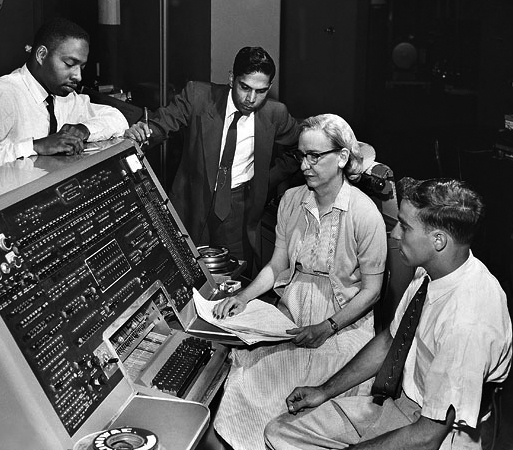Women’s History Month highlights lesser known accomplishments
The creation of an electronic computer, the popular Washington Post, and the moon landing all have one thing in common: they were made possible due to the contributions of women. The first Women’s History week was organized in 1978, during which informative presentations and contests shone a spotlight on various lesser known women who significantly impacted U.S. history. This movement spread across the U.S. until March was designated as Women’s History Month in 1987. Here are five women who paved the way for future generations of brilliant women.
Grace Hopper
Grace Hopper contributed to the foundations of the modern computer. According to Britannica, in 1949, Hopper pioneered the computer science field by developing the first commercial electronic computer called UNIVAC I. Later, she developed Mark I, the first large-scale automatic calculator and basis for electronic computers.
Additionally, she created the computer code called COBOL, common-business-orientated language, which is widely used today in businesses and the government due to its mathematical accuracy and its ability to handle large sets of data. Her contributions to the computer science field continue to inspire young girls to pursue careers in science and technology.
“From a quick Google search, you can see that only 20% of computer science professionals are women,” freshman Navya Madava said. “I don’t think it’s about a need for representation; it’s about access and exposure to STEM. Clubs like Girls Who Code and Women in Science target that issue by trying to get girls in high school exposed to the field of STEM so that they know what they want to do in the future.”
Hedy Lamarr
Beauty or brains? Hedy Lamarr had both. By the age of five, Lamarr was found disassembling and piecing back together a music box to understand its mechanisms. Not only was Lamarr gifted in technology, but she also gained name recognition in the 1930s for acting. She played prominent roles in European films and was dubbed the “most beautiful woman in the world.” Despite her success, her husband Fritz Mandl severely restricted her freedom and subjected her to verbal abuse.
“Not only did men have a lot more opportunities to contribute to society, but they actively pushed against women and prevented them from the same opportunities,” sophomore Roshni Ahuja said.
After divorcing Mandl in 1936, Lamarr moved to Hollywood and appeared in several films, including the Oscar nominated “Algiers.” She met George Antheil at a dinner party in 1940, and together, they invented a revolutionary device for radio communications to prevent radio jamming and keep Allied torpedoes from being detected by the Nazis.
Her work provided the basis for modern satellite and cellular technology. However, she was given little credit for her invention. According to Forbes, her lack of credit was likely to preserve her appearance in the public sphere as a purely glamorous movie star.
“When women made extraordinary discoveries, it was so out of their ‘role’ that it was seen as something bad and often overshadowed,” Ahuja said.
Nevertheless, she continued to influence the scientific world, producing inventions like stoplights and airline alterations like proposing new wing designs until her death in 2000.
Katharine Graham
The Washington Post owes its popularity and influence to the work of Katharine Graham. In 1972, Graham became the CEO of The Washington Post. Throughout the years she held that position, the stock of The Washington Post skyrocketed and the revenue soared over $1 million. Her position was significant during a time period where less than 0.2% of women held the CEO title in the U.S. The Washington Post thrived and gained recognition under Graham’s leadership.
Graham took a radical decision by publishing the Pentagon Papers, which revealed the truth of the Vietnam War compared to what the U.S. government told the public. As a result, the Nixon administration sued The Washington Post, but the Supreme Court ruled in favor of the newspapers under the First Amendment’s guarantee of freedom of the press. She continued to publish controversial stories including a report on the Watergate Scandal from 1972 to 1974.
“I believe now, as a society, we are progressing to a better understanding that despite gender, race or sexuality, we all have the potential to achieve greatness. The boundaries are limitless,” sophomore Grace Olander said.
Margaret Hamilton
Neil Armstrong may not have been the first man to walk on the moon if it wasn’t for Margaret Hamilton’s technological innovations. After studying math as an undergraduate, Hamilton worked at Lincoln Laboratory in the Massachusetts Institute of Technology from 1961 to 1963, where she was involved in the Semi-Automatic Ground Environment (SAGE) project, the first U.S. air defense system and identifying enemy aircrafts. Her achievements in the SAGE project allowed her to become the leader of the team that worked on on-board flight software for the “Apollo 8” mission.
“In big and little ways, women have enhanced American values and culture with their inventions, leadership and wisdom,” Brandquist said. “To me, Women’s History Month offers our citizens a chance to acknowledge and celebrate women’s triumphs.”
Ultimately, her program allowed for a successful landing on the moon. During the Apollo missions, when the software malfunctioned, the code she created saved the astronauts’ data, allowing for NASA to further their research in space.
Shirley Chisholm
Breaking barriers in politics, Shirley Chisholm was the first African American woman elected into Congress in 1969 and ran for the Democratic presidential nominee in 1972. Before she was involved in politics, she was an educator and received a master’s degree in elementary education from Columbia University. When she was in Congress, she advocated for improvement in education, fought for minority rights and pushed forward bills for domestic worker benefits. Additionally, she had advocated for programs like Head Start preschool, food stamps and free school lunches.
However, she had faced backlash throughout her campaign. According to WomensHistory, the Federal Communications Commission blocked her from participating in the televised primary debates, in 1972, due to her race and gender. Only after Chisholm took legal action did they allow her to give one speech.
“She knew the odds were against her, but she so strongly believed in the social justice issues she advocated,” history teacher Mary Brandquist said. “She believed running for president would at least promote her beliefs and lead to change.”
Despite facing discrimination and running a campaign that lacked funding, she received 152 votes from the delegates at the Democratic National Convention. Through her achievements, Shirley Chisholm showed that women have potential to achieve and take on a dominant position in politics.
Your donation will support the student journalists of Chantilly High School. Your contribution will allow us to cover our printing and annual website hosting costs.

Nithya is a junior and this is her second year on the Purple Tide. She is heavily involved in Debate, Red Cross and the Writing Center. Outside of school,...

Noya is a junior. She is involved in Chantilly debate, the literary magazine and the Virginia Youth Climate Cooperative science research team. In her free...


